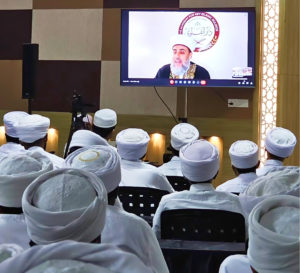It is not valid to perform this integral of tawaf except after the middle of the night preceding the ^Id day, whether before throwing the pebbles at the pillar of al-^Aqabah or after it, and whether before shaving or after it. It is better to perform this tawaf after throwing the pebbles at Jamrat al-^Aqabah and after shaving or trimming the hair.
Among the conditions for the validity of this tawaf is to be pure from all the ritual impurities and to be clear from the unexempted najas-filth. One must also cover the unlawful nakedness (^awrah), as in prayers.
The woman who is in her menses delays performing this tawaf until she is clear of her menses and has performed the obligatory purificatory bath (ghusl). It is not permissible for her to leave out performing this integral tawaf. Tawaf is performed by circling the Ka^bah seven (7) times, starting with the black stone, heading towards Hijr Isma^il, keeping the Ka^bah to ones left side all the time.
Turning only one’s head from side to side, without turning the shoulder does not affect the validity of the tawaf.
If one doubts about the number of circles completed, one takes by the least number one is sure one completed, as one does for the number of rak^ahs in prayer.
It is sunnah to perform tawaf by walking, but it is permissible to do so while riding an animal or being carried. The pilgrim makes his own personal du^a’ during the different rounds around the Ka^bah, asking Allah for matters which he likes pertaining to the religious matters or the worldly matters–for himself, for whom he likes, and for the Muslims in general. It is also good to occupy one’s time of tawaf by reciting the Qur’an. It is sunnah for the man to walk quickly with a short stride in the first three (3) rounds.
Women walk with a normal pace and a normal stride. Also sunnah for the man–in all the rounds–is to bring the rida’ (what he wears to cover the top part of his body) from underneath the right armpit and to hang it over the left shoulder.
It is sunnah for the women to wear the jilbab over their ihram clothes. The jilbab is a rida’ which covers the head, neck, chest, and back. Sometimes it might reach the ankles, and sometimes it might be shorter. After finishing tawaf, it is sunnah to pray two (2) rak^ahs.





